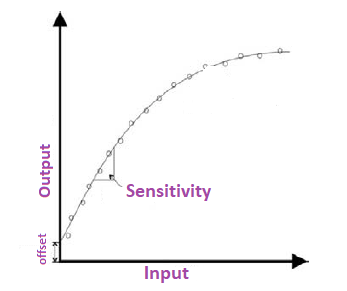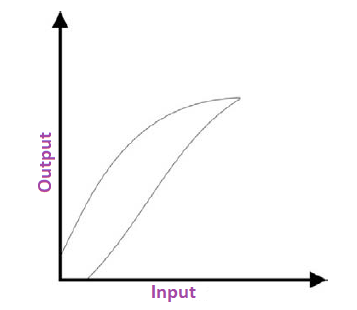The need for accurate medical diagnostic procedures places stringent requirements on the design and use of biomedical sensors. Depending on the intended application, the performance specifications of a biomedical sensor may be evaluated in vitro and in vivo to ensure that the measurement meets the design specifications.
The following definitions are typically employed when describing biomedical sensor characteristics and selecting sensors for particular applications.
Range
The range of a sensor corresponds to the minimum and maximum operating limits that the sensor is expected to measure accurately. For instance, a temperature sensor may have a normal performance over an operating range of -180 to 350 °C.
Sensitivity
Sensitivity is typically defined as the ratio of output change for a given change in an input. You can also define sensitivity by finding the slope of the calibration line relating the input to the output that is change-output/change-input. A high sensitivity implies that a small change in input quantity causes a large change in its output.

Accuracy
Accuracy refers to the difference between the true value and the actual value measured by the sensor. Typically, accuracy is expressed as a ratio between the preceding difference and the true value and is specified as a percent of full-scale reading. The true value should be traceable to a primary reference standard.
Precision
Precision refers to the degree of measurement reproducibility. Very reproducible readings indicate a high precision.
Find out more about: Fingertip Pulse Oximeter Blood Oxygen Saturation Monitor
Resolution
This is the smallest distinguishable input change that can be detected with certainty.
Offset
This refers to the output value when the input is zero.
Reproducibility
Describes how close the measurements are when the same input is measured repeatedly overtime. When the range is small, the reproducibility is high.
Linearity
This is the measure of the maximum deviation of any reading from a straight calibrated line. Typically, sensor linearity is expressed as either a percent of the actual reading or a percent of the full-scale reading. Note that though a linear response is sometime desired, accurate measurements are possible even if the response is nonlinear as long as the input-output relation is fully characterized.
Related: What is a Biosensor?
Drift
Refers to the change in sensor reading when the input remains constant. To determine zero drift, the input is held at zero while the output reading is recorded. For instance, the output of a pressure transducer may depend not on only on pressure but also on temperature. Thus, variations in temperature can produce changes in output readings even if the input pressure remains zero.
Response Time
The response time indicates the time it take a sensor to reach a certain percent e.g. 93% of its final steady-state value when the input is changed. For example, it may take, 25 seconds for a temperature sensor to reach 98% of its maximum value when a change in temperature of 1°C is measured. Ideally, a short response time indicates the ability of a sensor to responds quickly to changes in input quantities.
Related: 3 Roles Played by Smart Sensors in Biomedical Instrumentation
Hysteresis
For some sensors, the input-output characteristics follow a different nonlinear trend depending on whether the input quantity increases or decreases. For example, a particular pressure gauge may produce different output voltages when the input pressure varies from zero to full scale and then back to zero. When the measurement is not perfectly reversible, the sensor is said to exhibit hysteresis. If a sensor exhibits hysteresis, the input-output relation is not unique but depends on the direction change in the input quantity.

Related: Blood Glucose Sensors

Leave a Reply
You must be logged in to post a comment.